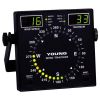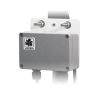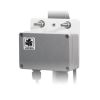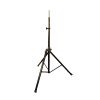YOUNG Heavy Duty Alpine Wind Monitor
Features
- Extremely long-wearing, oversize ceramic bearings to extend service
- Oversized propeller shaft
- Ice-resistant coating with all-black color scheme for harsh alpine conditions
- Free ground shipping
- Expedited repair and warranty service
- Lifetime technical support
- More
The Wind Monitor-HD-Alpine has all the important features of the Heavy Duty unit that greatly extend the service life. It promises improved survivability for the most severe wind measuring applications. In addition, it has the benefit of a specially formulated, ice-resistant coating on the external surfaces to improve performance in harsh alpine condtions.
The reliability of the Wind Monitor sensor is well known. The sensitive vane and propeller combination has proven effective for countless applications in many disciplines. The Wind Monitor-HD (Heavy Duty) model is designed to address the most common concern of mechanical wind sensors: bearing replacement.
The HD utilizes extremely long-wearing, oversize ceramic bearings to increase servcie life many times longer than standard stainless steel bearings. In addition to being more wear-resistant, ceramic is resistant to corrosion in environments that are hostile to steel bearings.
The Wind Monitor-HD also has oversized propeller shaft, high pitch propeller and stainless steel locking propeller nut, all features that will enchance long-term reliability of the sensor. The instrument mounts on standard 1 inch pipe.
Range:
Wind speed: 0-100 m/s (224 mph)
Azimuth: 360° mechanical, 355° electrical (5° open)
Accuracy:
Wind speed: ± 0.3 m/s (0.6 mph) or 1% of reading
Wind direction: ± 3 degrees
Threshold: Propeller: 1.0 m/s (2.2 mph) Vane: 1.0 m/s (2.2 mph)
Signal Output:
Wind speed: magnetically induced AC voltage, 3 pulses per revolution.
Azimuth: analog DC voltage from conductive plastic potentiometer − resistance 10K Ω , linearity 0.25%, life expectancy − 50 million revolutions
Power Requirement:
Potentiometer excitation: 15 VDC maximum
Sensor Cable:
A 3 meter (9.8 ft) pigtail cable is supplied for electrical connections.
For longer cable lengths a user supplied junction box or connector may be used.
Dimensions:
Overall height: 37 cm (14.6 in)
Overall length: 55 cm (21.7 in)
Propeller: 18 cm (7 in) diameter
Mounting: 34 mm (1.34 in) diameter (standard 1 inch pipe)
Weight:
Sensor weight: 1.0 kg (2.2 lbs)
Shipping weight: 2.3 kg (5 lbs)
In The News
Village Green Project builds air quality awareness with monitoring park bench
The U.S. Environmental Protection Agency is on a mission to make air quality monitoring cheaper, easier and more accessible through the implementation of innovative new monitoring stations. The Village Green Project is a new initiative from the EPA that seeks to increase the scope of air quality monitoring by seamlessly incorporating monitoring devices into community settings. Led by Gayle Hagler, an environmental engineer at the EPA Office of Research and Development, an EPA design team has constructed a prototype that combines the ability to monitor ozone and fine particulate matter as well as wind speed, wind direction, temperature and humidity all into the functional design of a park bench.
Read MoreUNC's industry-standard water quality profiling platforms get upgrade
The University of North Carolina Institute Of Marine Sciences has a history with profiling platforms. UNC engineers and scientists have been building the research floaters for 10 years in a lab run by in Rick Luettich, director of the institute. UNC scientists and engineers developed their own autonomous vertical profilers to take water quality readings throughout the water column. They have three profilers placed in the New and Neuse rivers. The profilers are designed to drop a payload of sensors to an allotted depth at set time intervals. Instruments attached take readings continuously on the way down and up. Data collected by the profilers has been used to study water related issues such as infectious disease and sediment suspension.
Read MoreUSGS weather station network monitors Arctic Alaska's climate
When the U.S. Geological Survey began building their climate and permafrost monitoring network in Arctic Alaska in 1998, there wasn't much precedent for how to build the infrastructure for the instruments in the region's unforgiving environment. That meant the scientists had to learn the particulars on the fly. For example: On the great expanse of flat, barren tundra, a weather station sticks out like a sore thumb to a curious grizzly bear. "The initial stations were pretty fragile," said Frank Urban, a geologist with the USGS Geosciences and Environmental Change Science Center. "So the bear and those stations--the bear won every single time without any problem.
Read More

















